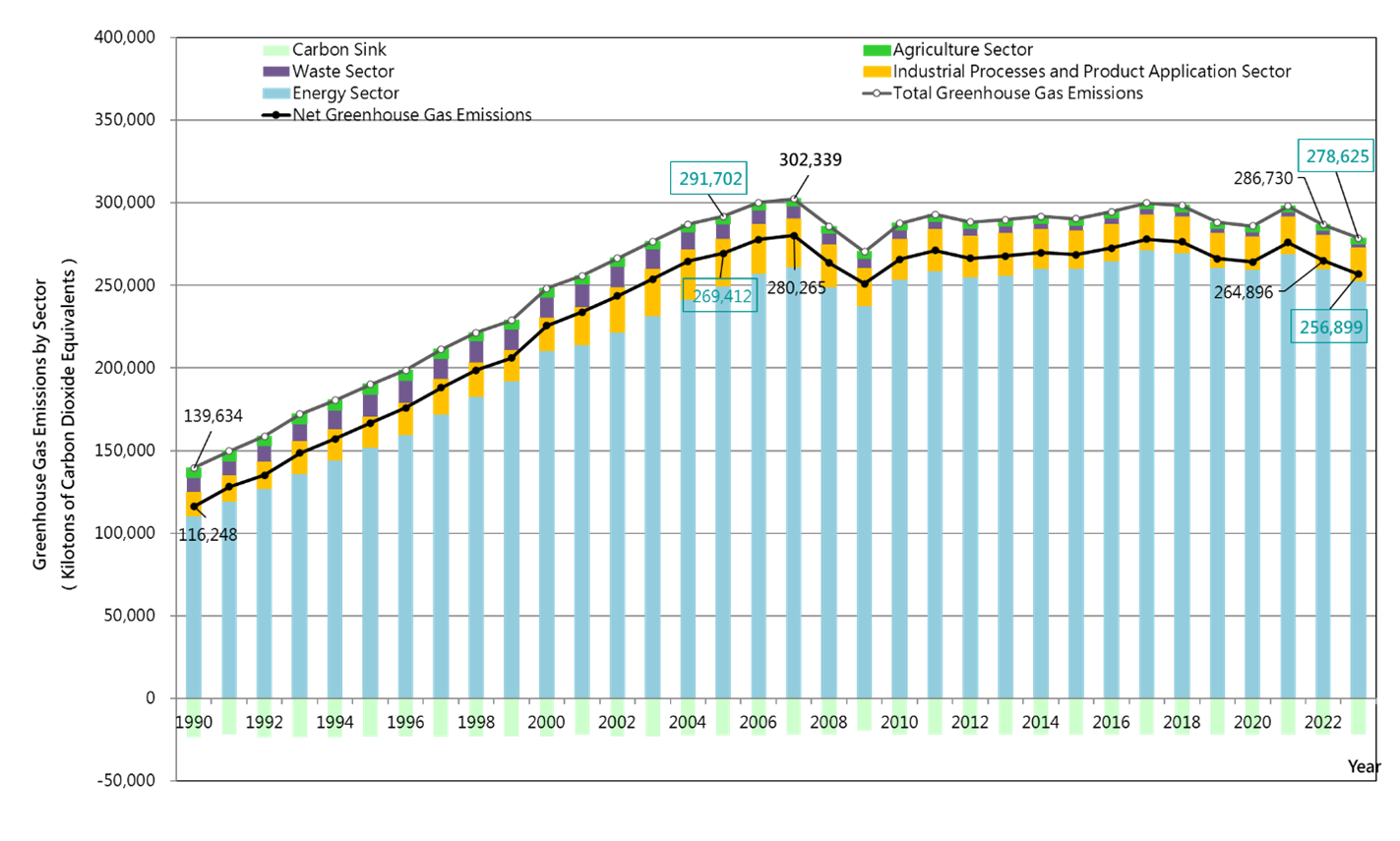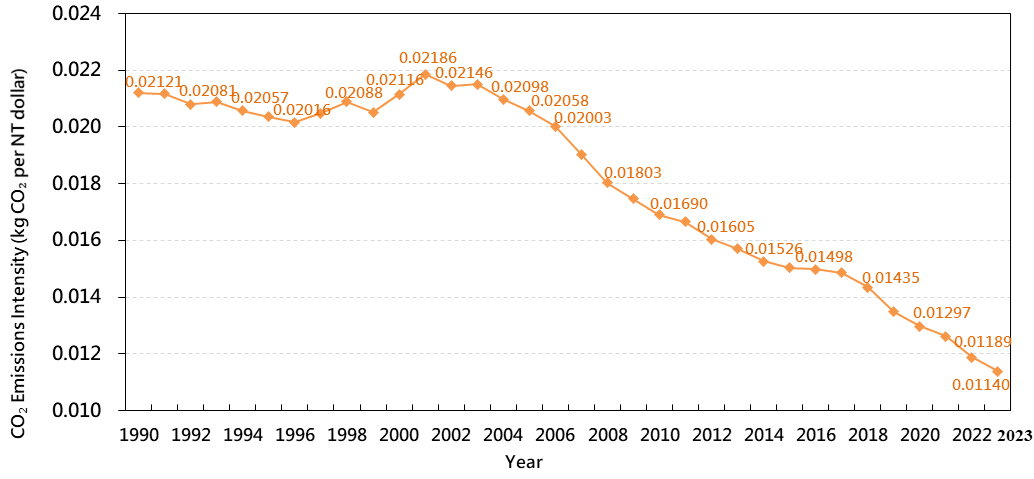Ministry of Environment Aligns with International Standards and Releases the Latest National Greenhouse Gas Inventory Taiwan Achieves a 4.64% Reduction in Net Emissions Compared to the Base Year
Share to Line Share to Facebook Share to X Print ContentIn compliance with Article 13 of the Climate Change Response Act and in alignment with the United Nations Framework Convention on Climate Change (UNFCCC), the Ministry of Environment has collaborated with various government agencies to compile the “National Greenhouse Gas Inventory (2025 edition),” which is now available on the “Climate Info Hub.” According to the statistical results, Taiwan’s total greenhouse gas emissions in 2023 were 278.63 million metric tons of CO₂e, a 4.48% reduction compared to the 2005 baseline year. After accounting for carbon sinks of 21.73 million metric tons of CO₂e, the net emissions were 256.90 million metric tons of CO₂e, representing a 4.64% reduction from the baseline year and a 3.02% decrease from the previous year (2022). This indicates that Taiwan's overall greenhouse gas emissions are showing a downward trend.
The Ministry of Environment stated that, under the requirements of UNFCCC, Annex I countries must submit their National Inventory Reports (NIR) on greenhouse gas emissions for the two years prior. So far this year, 40 countries have published their 2023 inventories online. Although Taiwan is not a signatory to the UNFCCC, it has voluntarily aligned with global standards. Since 2015, Taiwan has published its annual greenhouse gas inventory reports in accordance with the Intergovernmental Panel on Climate Change (IPCC) Guidelines for National Greenhouse Gas Inventories. Taiwan’s data has also been recognized and included by international research bodies such as Germany’s Potsdam Institute for Climate Impact Research (PIK).
The Ministry of Environment announced that the full report of the “National Greenhouse Gas Inventory (2025 edition),” along with an executive summary (see attached), is now available for public download and reference through the “Climate Info Hub” (https://gov.tw/9EA). A breakdown of the analysis is as follows:
- According to the emissions trend over the years, Taiwan's greenhouse gas emissions have generally been on a downward trend since peaking in 2007. There was a brief uptick in 2021, driven by post-COVID recovery and economic rebound, but emissions resumed their steady decline in both 2022 and 2023 (see Figure 1).
- In 2023, carbon dioxide (CO₂) was by far the dominant greenhouse gas, making up 95.86% of total emissions. Methane (CH₄) contributed 1.60%, and nitrous oxide (N₂O) accounted for 1.31%. Sectoral data from the inventory indicate that CO₂ emissions from fuel combustion account for 90% of Taiwan’s total greenhouse gas emissions.
- Based on the analysis (as shown in Figure 2) of CO₂ emissions intensity (i.e., CO₂ emissions per unit of GDP), Taiwan emitted 0.01140 kg CO₂ per NT dollar in 2023, which reflects a 4.14% decrease compared to 2022, and a 44.62% reduction from the base year, demonstrating continuous improvement in Taiwan’s energy efficiency.
- Compared with global greenhouse gas emission trends, global data from the European Commission’s Joint Research Centre (JRC) and the EDGAR (Emissions Database for Global Atmospheric Research) show that worldwide greenhouse gas emissions reached 53 billion metric tons CO₂e in 2023, which is a 1.9% increase from the previous year, setting a new record high. In contrast, Taiwan’s emissions continued to fall, with both CO₂ emissions intensity and per capita emissions showing improvement. This underscores Taiwan’s sustained efforts to cut emissions and the growing decoupling of emissions from economic growth.
The Ministry of Environment further explained that the greenhouse gas inventory is a critical tool used to track Taiwan’s progress toward meeting its national emissions reduction goals. Starting in 2026, Taiwan will enter the third phase of its staged emissions control goals. On May 6, 2025, the Executive Yuan officially approved the “Phase 3 Greenhouse Gas Periodic Regulatory Goals” (2026–2030). In line with the Climate Change Response Act, the six key government ministries responsible for different sectors will be required to update or draft their respective sectoral emissions reduction plans within six months. Local governments must follow by revising or preparing their local implementation plans within eight months. Throughout this process, the relevant authorities will adhere to legal requirements to ensure transparency of information and public engagement. Information regarding the previously mentioned staged goals, draft plans, and public hearings will be made publicly available on the “Climate Info Hub.” The public will be able to submit written comments online or sign up to attend the public meetings during the official review period. These opportunities aim to ensure that public opinions are considered in the finalization and approval of the plans, promoting nationwide collaboration in reducing greenhouse gas emissions.

Figure 1- Trend of greenhouse gas emissions in Taiwan

Figure 2 - Trend of CO₂ emissions intensity in Taiwan
Related Links
- Source:
- 環境部氣候變遷署
- Published:
- 2025-05-26
- Updated:
- 2025-06-26
